386 Search Results for complex communication
February 23, 2013
by Robin Parker -
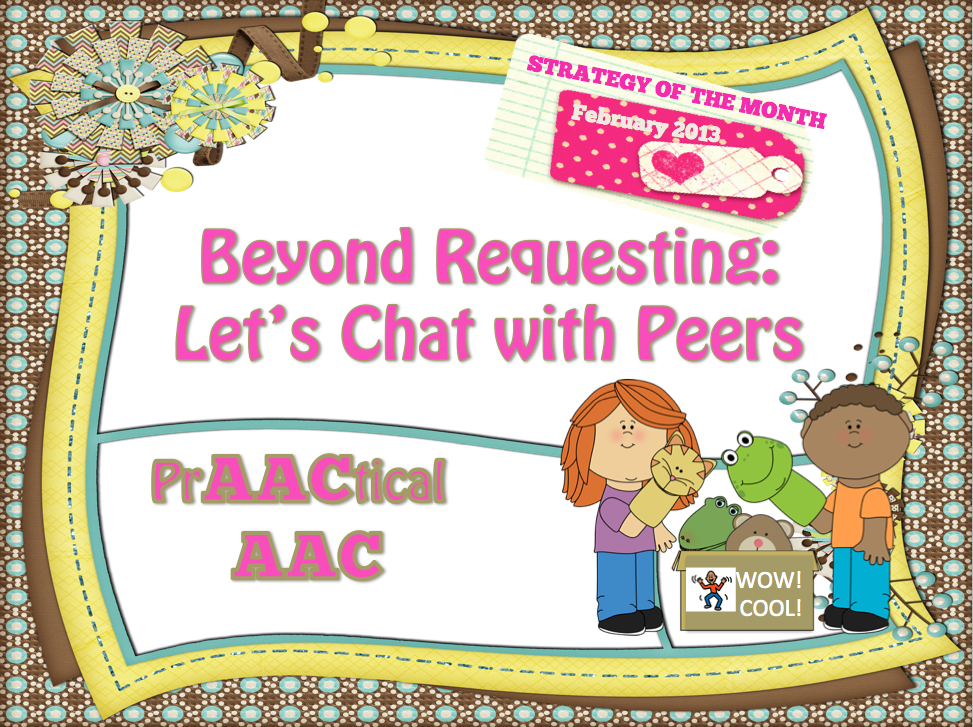
As we wrap up the February Strategy of the Month, we need to add strategies for helping AAC users talk/chat with peers. For some learners, it is more about providing access and opportunity while for others, it is more about providing a platform for the social awareness and exchange. However, for all learners who need assistance in ‘chatting’, there are many goals and strategies that will help. Setting the Foundation for Social Exchanges with Peers Provide frequent opportunities for peers to communicate with each other- Build in many opportunities within all (or almost all) activities for generic small talk, gossiping, & chatting. Create activities that have’ built in’ communication with peers- develop activities that require communication with peers to make the activity work. Instead of having all communication directed at the adults/facilitators in the room, have the learners talk to peers to take steps in the activity. Set up... [Read More...]
January 17, 2013
by Carole Zangari -
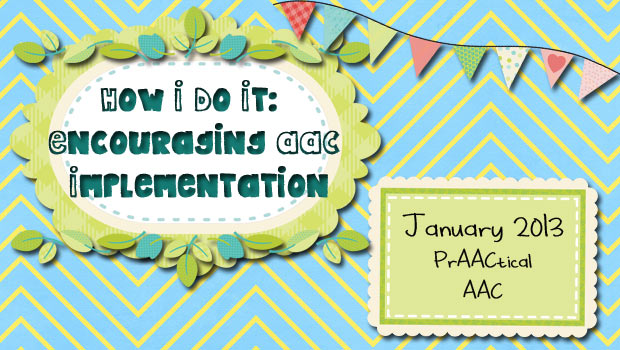
Nothing makes us happier than hearing AAC success stories. It’s thrilling to hear of folks who are using AAC tools and strategies to communicate effectively. We love hearing how their language develops and the positive changes that makes in their lives. It also makes us curious as to what made ‘this’ story a success story. One of our goals for the new year was to give PrAACtical AAC followers a look into the experiences of professionals outside their own communities. Last week, we introduced AACtual Therapy, a series of guest posts by SLPs who are willing to give us a peek into their AAC therapy sessions. Today, we introduce How I Do It, a series in which we invite SLPs to share how they tackle common issues, tasks, or problems. We’re excited to launch the series with a post from Lauren Enders, a clinician who supports the AAC community beyond... [Read More...]
October 30, 2012
by Carole Zangari -
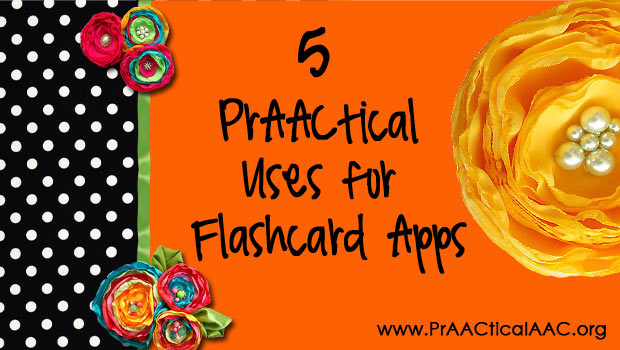
We love AAC intervention that begins and ends with a context that is meaningful to the learner. Not only is contextually relevant therapy more engaging and fun for the learner (thus, easier on the clinician!) but it promotes generalization to real-world contexts. So we’ve never been terribly fond of therapy that uses flash cards, or, more recently, the digital versions on iOS or Android devices. It’s a shame, really. There are a lot of those kinds of apps, and many of them have great graphics. That got us to starting thinking: What could we use them for that improves real communication and AAC learning? PrAACtical Uses for Flashcard Apps Make a Mini Schedule: Lots of people with AAC needs use paper-based picture schedules that depict the activities they do throughout the day. A flashcard app could be used in conjunction with those to show the steps or parts of an... [Read More...]
October 25, 2012
by Robin Parker -
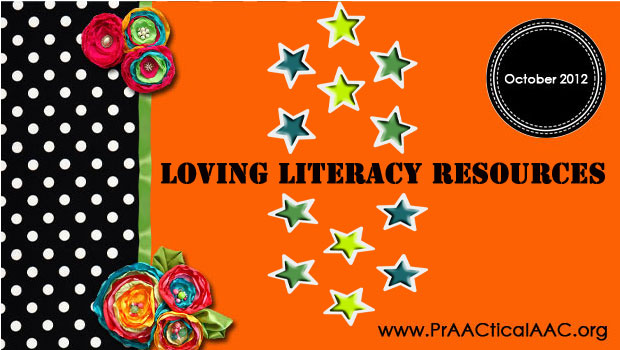
For AAC Awareness Month, we would be remiss if we did not think about literacy. It is a form of communication and language that supports AAC use. Sometimes literacy is difficult for our students, other times it is actually easier and it helps conversational communication and even natural speech. Either way, reading, writing, talking, and listening (understanding) are all modalities of language. There are so many great resource lists for supporting literacy: Jane Farrall’s Letter of the Week: Resources for Older Students, Spectronics Apps for Literacy Support, Melissa Taylor’s 24 Educational iPad Apps for Kids in Reading and Writing, and 25 Great Children’s Apps to Stimulate Literacy, Learning, & Creativity just to name a few. We wanted to share a few additional resources for literacy with general education apps that approach reading through fun with words. And any literacy discussion could not be complete without some seriously great literacy information, theory, and supports... [Read More...]
October 20, 2012
by Robin Parker -
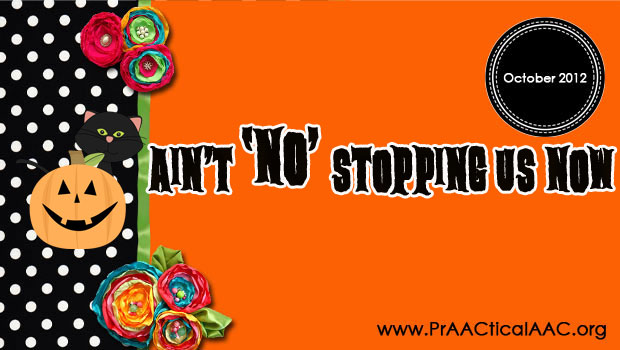
Sometimes saying ‘no’ to the demands of the day actually helps us rejuvenate and allows us to be more productive. Saying ‘no to false information helps us to advocate for ourselves. The ‘no’ topic seems to be trending now. There have been quite a few blog posts and comments about the issue (Just Say No, How and When to Give Your Students A Break). We are so glad that this topic is getting more focus. Of course everyone agrees that ALL people have the right to say ‘no’. But it is not always so simple. There are many types of ‘no’. There is the outright ‘no’, the ‘no’ to more work, the ‘no’ for disagreement, the ultra important ‘NO’ to unwanted touching, and many more. And depending upon how you say ‘no’ is the difference between it being accepted or… NOT. The issue of saying ‘no’ gets more complicated when... [Read More...]
October 8, 2012
by Carole Zangari -
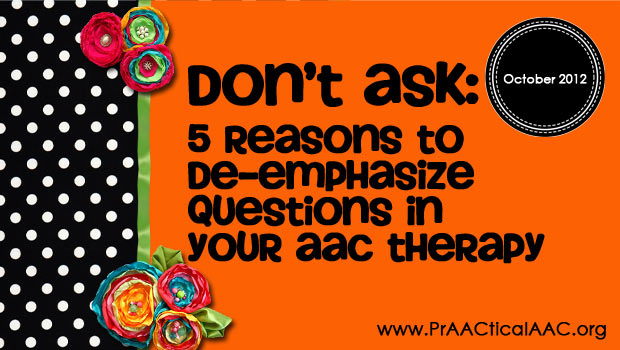
Questions are more like assessment than they are like instruction. Don’t believe us? Look at the questions these therapists posed and see if you didn’t feel like you were being quizzed. What’s your name? Where do you live? Do you know your address? How old are you? When’s your birthday? What school do you go to? What’s your teacher’s name? What’s that called? What do we do with that? Can you tell me more about it? Just to be clear, we think data-based decision-making always plays an important role in good therapy. However, assessment is assessment. Assessment helps us figure out what to teach and how to teach it. But it should look and sound very different than instruction. So when the SLP tells us she is going to teach a new skill by asking a question, we start to tense up. Here’s why we’re de-emphasizing questions in our AAC... [Read More...]
July 29, 2012
by Carole Zangari -
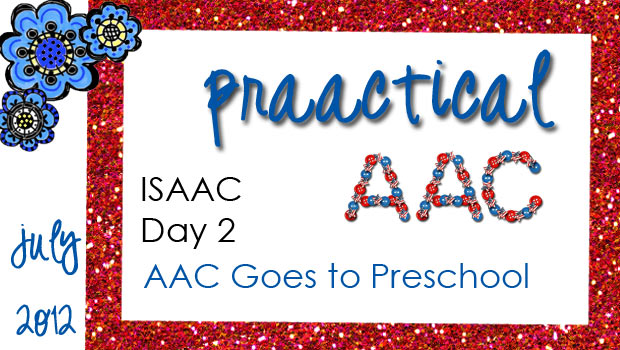
It was another wonderful day here in Pittsburgh at the 15th Biennial ISAAC Conference. It was a special day for me because I had the opportunity to speak about a really fun topic, core vocabulary teaching for young children with AAC needs. It was certainly a group effort! A talented graduate student of ours, Tathiane Paiva, and I shared a framework for developing a curriculum to teach core language in preschool classrooms, and used the curriculum I developed with Lori Wise (special educator and literacy specialist with UM NSU CARD) as an example. The basic principles behind the approach we shared are listed below. – •Language and literacy learning happen all day long. •Children learning AAC need high-quality instruction to learn and use basic vocabulary. •Children learning AAC need frequent opportunities for learning and practice. They need dozens of carefully planned opportunities to use their new words each day. •The focus is on... [Read More...]
July 21, 2012
by Robin Parker -
A ‘funny area’ is not a technique or strategy you will see in a behavior or speech-language therapy text-book. But here is how we came to know and love ‘funny time’ & the ‘funny area’ A Little Background Tommy, a 9-year-old boy, seemed to be getting the ‘giggles’ each session. The graduate student clinician was not sure how to ‘control the situation’. Tommy typically worked hard using his Vantage Lite to build long and complex sentences for communication during natural age-appropriate activities (i.e., golf, art, and reading). But then the ‘giggles’ would start… and less and less communication was getting done. Initially, the clinician spent time redirecting Tommy. She would have him sit straight, pay more attention, and re-focus, but in the long run it would be more about what the clinician wanted then about Tommy communicating. We prompted the graduate student to think about how more could be accomplished,... [Read More...]
June 2, 2012
by Carole Zangari -
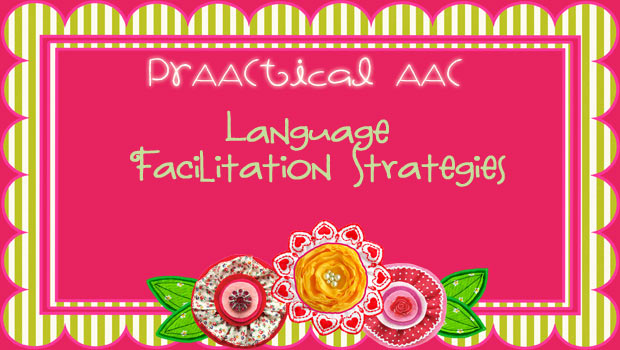
Well, it’s Week 4 of the new semester, and in our AAC classes, we’ve been talking a lot about how language is represented and organized in communication boards/books, SGDs, and AAC apps. We’ve talked about the pros and cons of representing language in various ways and discussed the options for setting up displays so that people can easily access the words they need. At this point, we know how to choose appropriate symbols, select appropriate vocabulary, and arrange it in an appropriate format. In short, we know how to put language ‘in.’ Now comes the hard part: Getting it out. How do we get people to actually use the language that’s been so carefully stored in the no-tech, low-tech, and high-tech AAC tools? Our June Strategy of the Month is about techniques for language facilitation. If you’re an SLP well-versed in language therapy with speaking children, these posts will cover... [Read More...]
May 17, 2012
by Carole Zangari -
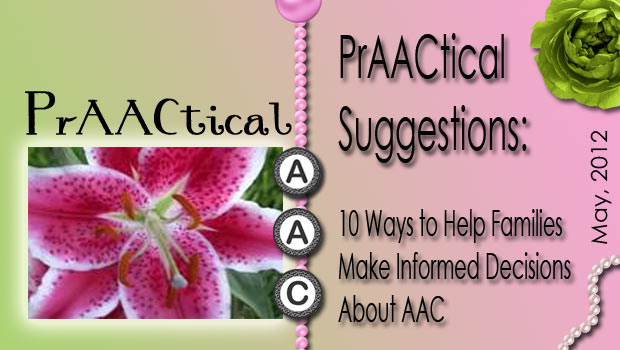
– In one of my AAC classes, we’ve been talking about how to help families make informed decisions. To do that, they need to have solid information presented clearly, in digestible bites from a trusted source. When we don’t have that information, it is easy to fall prey to fads and/or adopt a herd mentality and do what everyone else is doing. Here are some suggestions for supporting families through the AAC decisions they will need to make. – 1. Have direct conversations about the pros and cons of the available options. For example, if the family expressed interest in an iPad with AAC apps over a full fledged SGD, then we’d have to be prepared to reiterate the merits and drawbacks of each. 2. Share a process for making AAC decisions rather than attempting to take the decision out of their hands. For example, you may want to encourage... [Read More...]








